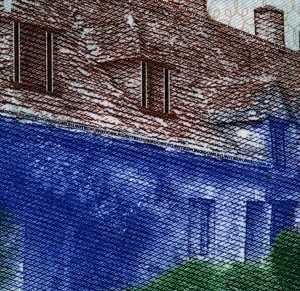UKUKUKUKUK
Louis Mackay
The latest design of UK passports, released last year, has a number of new security features: the chip is now hidden within the cover boards, which makes it more difficult to extract and replace fraudulently; the passport number is dot-matrix‐punched through every page; page numbers are both watermarked in the paper and integrated into the collaged pictorial backgrounds which, intaglio printed in fine detail and subtle colour blends, span each two‐page spread. Every background is different, and includes a good deal of microscopic text. The bearer’s photograph is transparently overprinted, so the continuity of the page’s background patterns is visible through it. The photo is also repeated on the adjacent page, where it appears to be of even poorer quality. Close examination reveals that the wavy colour screen with which it is printed is made up of multiple repetitions of the bearer’s surname and date of birth, in tiny lettering. An assortment of new, semi‐visible holograms is embedded in the multi‐layer lamination that covers the principal photo and the personal details.
Passport designs were until relatively recently based on abstract patterns and colour transitions. The first pictorial UK passports, introduced in 2006, featured a series of nicely engraved British birds, and kingfisher watermarks. The pictorially far more complex pages of the new passport now almost resemble banknotes, and they are produced by one of the world’s biggest banknote-printers: De la Rue.
Security considerations explain functional aspects of the new passport design, but not its iconography or aesthetic qualities. These have presumably been shaped with forethought, and with government and palace approval, to influence the bearer’s own sense of national identity. Our passports, unlike banknotes, are unlikely to get more than passing scrutiny from anyone else.
The inside cover is adorned with images of green oakleaves and acorns, a small purple butterfly and row of Cotswold cottages: Britain of flora, fauna and heritage – or rather, at least at first sight, an England. You need a high-power magnifier to discern the microscopic text, UNITEDKINGDOMUNITEDKINGDOMUNITEDKINGDOM, which runs like rainwater along the gutter below the cottage roof.
The bearer’s identity details now occupy a double spread, helpfully positioned nearer the front, so immigration officials in other countries should waste less time than they used to irritably flicking through the pages in search of them. The background features an outline map of Britain, crossed by the curving line of triangles and semicircles with which meteorologists mark an occluded front.
Over the Hebrides soars a fulmar – and in its shading, through a magnifying glass, you can read the micro text FULMARFULMARFULMAR, lest anyone should mistake it for a gull. To the east, hovering off the Yorkshire coast, is the dark blue, swallow-tailed silhouette of a tern, while to the west a small, mixed flock of birds of uncertain identity intrudes over the bearer’s principal photo, along with the foam of some decoratively curling holographic waves. The background image is crossed by an array of straight and wavy lines. Again it needs a lens to reveal that some of these are composed of miniature texts. Like archaic classical inscriptions, they lack spaces between words, and suggest the cries of seabirds, or the found poetry of the Shipping Forecast:
UKUKUKUKUKUKUKUKUK
CROMARTYFORTIESFORTHFISHERTYNEDOGGER
GERMANBIGHT…
HUMBERTHAMESDOVERWIGHT
Every page is watermarked with a bouquet of roses, thistles, daffodils and shamrocks, as well as with butterflies carrying the page numbers on their wings. And each double spread in the main body of the document has a pictorial background. Besides repetitions of the words ‘UNITED KINGDOM’, which the eye can only resolve at a distance from the interference patterns generated by intersecting layers of wavy lines, the montage illustrations have several common elements: a rural landscape; an array of weather map symbols; a thermometer scale (showing the page number in degrees Celsius); and a bit of banknote ornament bleeding off the edge of the page. Each double page also has a prominent heading that seems to have been borrowed from a school geography textbook: REEDBED, GEOLOGICAL FORMATION, COASTAL CLIFF, FISHING VILLAGE, BEACH, CANAL, VILLAGE GREEN, FORMAL PARK, WOODLAND, LAKE, RIVER, MOORLAND, MOUNTAIN. The weather map elements show Atlantic fronts, arrows of wind, symbols of cloud and rain followed by sun, or snow, but ending with rain. It is hard not to wonder if the meteorological character is not intended as a metaphor of national temperament – simultaneously warm and cold, blunt and sharp, wet and dry, unstable, on the edge of depression.
The imagery presents a conservative, not to say nostalgic, view of Britain as a cloudy, often wet country of landscape and built heritage. Its inhabitants are unseen. Apart from one glance at the fishing industry (a singularly beleaguered area of Britain’s economy), there is no evidence of any industry or occupation that our futures might depend on. The complete absence of any image of a city – even an old city – is to represent a Britain that most passport-holders may visit from time to time, but don’t live in.

Comments